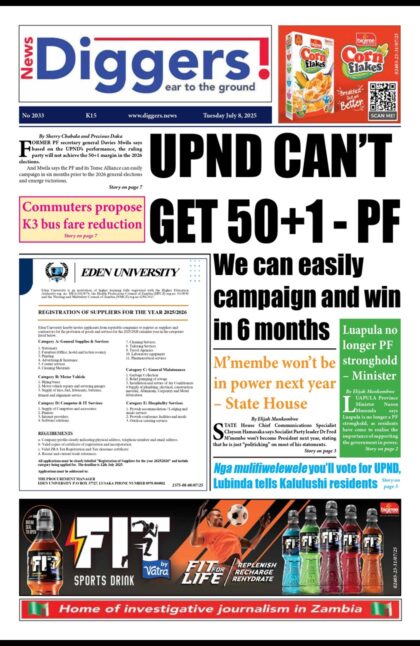The PF government has been very economical on the facts about Zesco. How does a government manage a country with this high level of incompetence and lies? This is what we know from the information we have been able to gather from government and other sources. Maamba Collieries is a joint venture with government. It is a reliable source of electricity producing 300MW. Zesco has a power purchase agreement and they are defaulting on monthly payments.
The Zesco Power Purchase Agreement with Maamba Collieries for the 300MW Maamba power plants is: Available capacity: 264 MW, Capacity charge: US $ 42.37 per available kW per month and energy charge, including fuel cost: US $0.0308 per kWh. The overall cost to Zesco, including the power plant and transmission is, US $0.108 per kWh.
Zesco, it is said, owes Maamba Collieries about US $149 million. What does this tell investors that go into business with a government-owned company under the Public Private Partnership? You cannot trust this government! This is a government who is very apt at not paying its bills. The last publicly available information on Zesco financials show that in 2016, borrowings were K12.592 billion and in 2017 was K12.8 billion; however, no information is available on Zesco’s debt position.
The findings of the Auditor General (AG) 2015 audit of Zesco concerned the Lusiwasi (12MW) and Lunzua (14.8 MW) hydropower projects. A letter of intent had been signed by the Government of the Republic of Zambia (GRZ) and China National Electrical Engineering Company (CNEEC) in July, 2009, with Zesco nominated by GRZ as the implementing agent. GRZ requested the Export-Import Bank of China (CEB) to extend a Preferential Buyer’s Credit for both projects amounting to 85 per cent of total capital cost. CNEEC was mandated to arrange the financing.
In July, 2011, Zesco entered into two contracts with CNEEC for the design, procurement and commission the two plants at contract cost of US$ 164 million and US$ 52 million, respectively. It was agreed that CNEEC would facilitate 85 per cent of project costs from CEB and GRZ would provide the remaining 15 per cent from its own resources.
The AG’s Report observes that the contracts were not shown to the AG, the contractor was single-sourced, contrary to the provisions of Public Procurement Act, and investment funds should have been made available before the contract was signed. Zesco had signed the contract and made a 15 per cent advance payment of US $32 million, while CNEEC failed to arrange the remaining 85 per cent of the cost of the project.
The initial contract completion date was September, 2012, but was later revised to September, 2014. The Lunzua Hydro Power Station was officially commissioned on 9th April, 2015. Zesco had wished to terminate the contract, but it was decided that this would be too costly. A physical inspection of the project by the AG team in December, 2015, revealed several defects.
The AG’s Report also observed problems with the contract for transmission connection for this project. Zesco had entered into an agreement with PME Power Solutions (India) Ltd in June, 2011, to design, manufacture, test deliver, install, complete, and commission the 132kV transmission line from Luangwa to the Zesco grid at a contract price of ZMW630 million (US $63 million). But, as of December, 2015, the project had not been completed and Zesco had not claimed liquidated damages.
The electricity crisis of 2015:
In February, 2016, the Minister of Energy and Water Development read a statement to Parliament in relation to the power supply crisis of 2015. This crisis had a major impact on Zesco’s costs and sales in 2015. From September to December, 2015, Zesco had spent a total of US$ 40 million on the import of 148MW of power from emergency power plants of Aggreko in Mozambique at an average cost of US$ 0.18 per kWh.
Zesco entered into a number of agreements for 2016, including the purchase of 40MW from Aggreko’s plant at a cost of US $5.5 million per month and Power Purchase Agreements with various Independent Power Producers (IPPs) and utilities in the region through SAPP. These included:
Karpowership: 100MW of emergency power for a period of two years at US $0.167/kWh from a floating power ship at Ncala port in Mozambique and burning heavy fuel oil (HFO). The 100MW is to later migrate to 200MW. The PPA was reported in the statement to have been signed and the first 100MW had docked on 19th February, 2016, with commercial operations expected to commence in March, 2016. This was expected to cost Zesco and GRZ about US $146 million annually.
EDM: Up to 150MW of firm supply to commence on 1st January, 2016, at a price of US $0.14/kWh and indexed to US producer prices. The PPA is for a period of 24 months at an annual cost expected to be approximately US $122 million. The statement indicated that negotiations had been concluded, but not necessarily signed at that date.
ESKOM: The statement said that Zesco has successfully negotiated a PPA with Eskom for the purchase of between 50MW and 300MW of emergency power for a period of 12 months, mostly at off-peak times at prices expected to vary from ZAR800/MWh (US $0.06/kWh) to ZAR2,600/MWh (US $0.19/kWh), depending on the time of use. The actual prices would be based on prices to be notified by ESKOM to SAPP.
This is how Zesco has brought us where we are. So much money borrowed, invested in the power utility, but still no solutions to the energy crisis!




















3 responses
I expected the article to elucidate on how much income Zesco has had from local and international customers. Also the adverse effects brought by Rural electrification or a report from REA
Funds may have been siphoned through zesco, new Government must seriously conduct an audit in 2022.
ZESCO also owes Lunsemfwa Hydro Power Company in Kabwe 60 Million Dollars. The company is crippled. If they were paid and producing they would contribute 60MW of power.